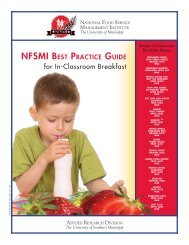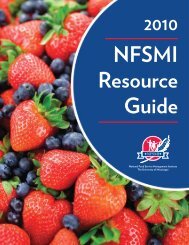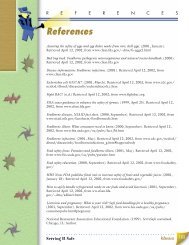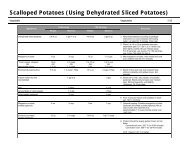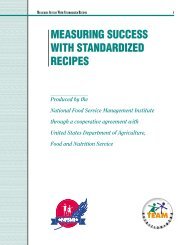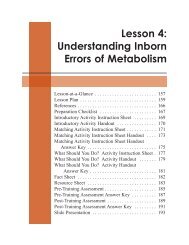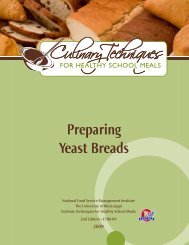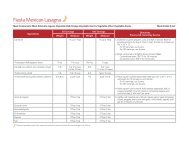financial management information system - National Food Service ...
financial management information system - National Food Service ...
financial management information system - National Food Service ...
Create successful ePaper yourself
Turn your PDF publications into a flip-book with our unique Google optimized e-Paper software.
S ECTION 4Financial Analysis and Program EvaluationSuccessful <strong>financial</strong> <strong>management</strong> of a school foodservice operation requires careful review and analysis of <strong>financial</strong> data. For<strong>financial</strong> data to be purposeful and useful, it must be easily understood, reliable, relevant, and timely. Understanding andmonitoring <strong>financial</strong> data can help decision-makers determine the profitability and efficiency of a school foodservice operationand identify areas for improvement. The relationship between available revenue and program costs must be evaluated on aregular basis. Increasingly programs are expected to be self-supportive and cost effective; this requires increased accountability.There are several types of analyses appropriate to generate performance indicators for evaluating the effective <strong>financial</strong><strong>management</strong> of a school foodservice operation. Performance indicators may be stated in dollars, percentages, or ratios tofacilitate the analysis process. NFSMI Task Force members identified the following performance indicators for “taking the<strong>financial</strong> pulse” of school foodservice programs:• <strong>financial</strong> position (statement of revenue & expenditures, balance sheet, budget variances, fund balance)• percent of cost by category to total revenue (operating ratios)• meal cost (plate cost, food cost/meal, labor cost/meal, commodity value/meal)• participation rate (by program, eligibility category)• productivity (meals per labor hour, revenue to variable costs)These performance indicators are meaningful only when compared to other useful criteria. One way to accomplish thiscomparison is through the utilization of an internal and external benchmarking process. Benchmarks are standards used to:• measure performance and• identify areas for improvement.Benchmarking data can be compared to:• corresponding data from the prior period; significant increases or decreases may be identified from this comparison,• planned goals such as the budget, participation, and meals per labor hour, and• other school foodservice operations with similar characteristics.The goal of benchmarking is to improve performance by adopting best practices of benchmarking partners. The use of “bestpractices” identifies operations of excellence and can help a school foodservice administrator answer questions about how thedistrict foodservice operation is doing when compared to other school districts.Meal EquivalentsIn school foodservice programs, the production of meals is the unit of measurement used to gauge the effectiveness andefficiency of a school foodservice program. The student reimbursable lunch is the standard unit of measurement most oftenused. Counting meal and food sales other than lunches is not as clear-cut as counting the traditional lunch. Thus, a methodfor converting operational data for all food sales, including student lunches, must be used to determine the equivalent of ameal. It is important to remember that a meal equivalent is not a unit of production but a calculation that allows the operatorto equate all meals to a standard, the student lunch. By converting all food sales to meal equivalents, the school foodserviceN ATIONAL F OOD S ERVICE M ANAGEMENT I NSTITUTE 64




